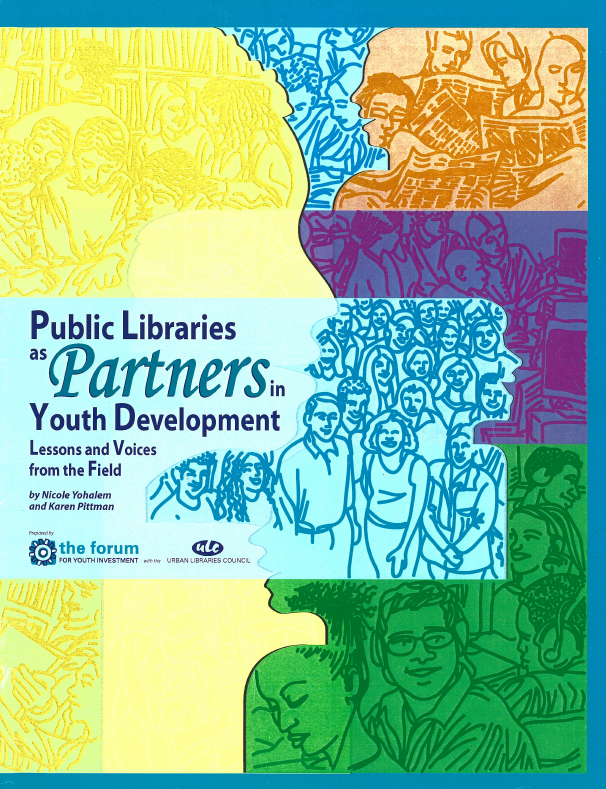
Schools have their agendas, parks have their niche, YMCAs have their angle. The library is viewed as neutral and can serve as the perfect link for all of these in a community. No matter what neighborhood the library is in, it gives kids the tools they need at their fingertips to be proactive about what they are learning. They have staff that can direct them to resources and help them find answers to the questions they have. Libraries are perfectly situated to be leaders in supporting youth development.
Darryl Bego, former project coordinator,
Public Library of Charlotte & Mecklenburg County
Building connections among the full range of organizations that invest in children, youth, families and communities has never been more important. There is unprecedented support for increasing the quality and quantity of supports and opportunities available to children and youth, and a growing sense that community resources must be enlisted to support young people’s education and development. Public libraries are among the most valuable institutions in the mix. And as they have in the past, libraries are stepping up to rethink their relevance and renew their commitment at a critical time.
While many libraries have been providing high-quality, innovation services to you youth since their inception, many have not fully realized their tremendous potential as partners in supporting young people’s learning and development. The Public Libraries as Partners in Youth Development (PLPYD) initiative, a four-year, $6 million effort sponsored by the Wallace-Reader’s Digest Funds, offered an unprecedented opportunity for libraries to work collaboratively with teens and community partners to understand and strengthen their commitment to the positive development of young people.
The initiative was timely. Like all public institutions, libraries operate under constant pressure to demonstrate their relevance by adapting and responding to pressing social issues of the day. In addition to infusing neighborhoods across the country with new supports and opportunities for young people, the PLPYD initiative gave nine public library systems a valuable opportunity to reflect, retool and reinvent their commitment to young people.
The national conversation about youth has shifted significantly in the last 20 years. The 1980’s saw a proliferation of policy agendas, programs, public awareness campaigns and large-scale research focused squarely on keeping teens out of trouble (and protecting communities from dangerous teens). Today’s public discourse, policy context and programmatic landscape reflect a more balance interest in helping young people avoid risks and preparing them to be fully engaged citizens, workers, parents and partners.
States and localities are increasingly focused on the need for youth to have not only safe but engaging opportunities during the out-of-school hours. Libraries can play a significant role during these hours through several strategies. As consistent employers of young people in roles ranging from book shelving to technology assistance, libraries represent an ideal first job and a gateway to respected profession. As they increasingly position themselves as indispensable bridges “between democratic values and technical progress,” libraries offer ideal setting for young people in identify community issues they care about and access knowledge and skills that enable them to act on them. And as free, respected and accessible neighborhood-based facilities that are in the information business, libraries are ideally positioned as hubs for formal and informal learning.
The current emphasis on out-of-school time is occurring in the context of broader reform and system-building efforts to create extended learning opportunities, link community resources with schools in meaningful ways and strengthen community-based supports and learning opportunities for young people. Whereas preventing problems was the shared focus of youth organizations in years past – a focus in which the role of libraries is less than clear – learning and engagement are increasingly topping the agendas of local, state and national youth organizations. This shift brings a new urgency to dialogue between youth organizations and public libraries.
Libraries that participated in the PLPYD initiative struggled to strike the right balance between innovation and tradition, between breadth and depth of services, between program development and policy change. They worked to build bridges between the perspectives of libraries and other community agencies, between youth workers and librarians, between teens and adults.
Page 11
Cognitive development is absolutely essential for full preparation. But in the drive for academic achievement, other key areas of development can get overlooked. Understanding the interconnections between them, we have to demonstrate respect for development across a range of other key areas – vocational, social, physical, civil, emotional and moral.
Page 9



No comment yet, add your voice below!